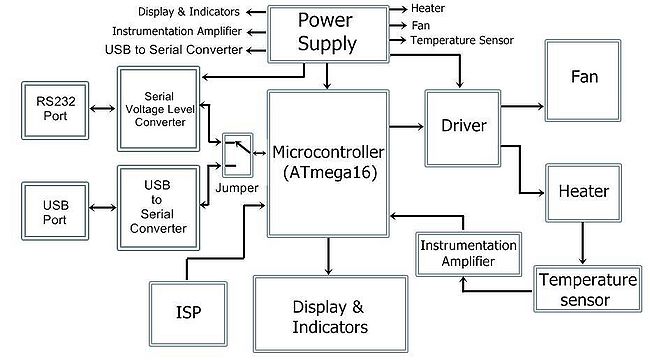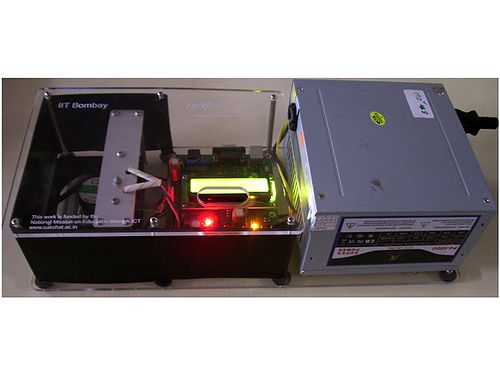Difference between revisions of "Single Board Heater System"
Rupakrokade (Talk | contribs) |
Rupakrokade (Talk | contribs) |
||
| Line 34: | Line 34: | ||
*Reset SBHS | *Reset SBHS | ||
| − | = | + | = Using Single Board Heater System remotely = |
1. Using SBHS Virtual Labs on Windows | 1. Using SBHS Virtual Labs on Windows | ||
*Software installations required to use SBHS remotely | *Software installations required to use SBHS remotely | ||
Revision as of 17:38, 5 May 2015
A single-board heater system is a low cost, open source, lab-in-a-box setup. It consists of a heater assembly, fan, temperature sensor, ATmega16 microcontroller and associated circuitry. A block diagram representation of the same is shown in figure below. A stainless steel blade whose temperature has to be controlled serves as the plant. Nichrome helical coil with 20 turns kept at a small distance from the steel blade, acts as the heater element. AD590, a monolithic integrated circuit temperature transducer, is soldered beneath the steel plate. A computer fan, a low cost and commercially off the shelf component, is used to cool the plate from below.
The plant has a small time constant, less than a minute, that allows completion of an experiment in a short time. This in turn facilitates performance of a large number of experiments in a single laboratory session. The speed of response not being too fast allows the measurements to be seen with naked eye, as it happens in industrial systems. It also demonstrates other measurement issues, such as, noise. The codes for hardware interface and control experiments, and manuals are available at http://fossee.in/moodle.
In these series of tutorials we would talk about the hardware device, its features and components. We would also talk about how to access this device using Scilab. These tutorials are made for both Ubuntu-Linux as well as Windows Operating System. We would also see how to access the SBHS device remotely under Virtual Labs project.
This device aims at serving a small portable lab for an individual or an institute. The application of this device is in the Control Systems area of Engineering. All Undergraduate level experiments and most Post graduate level control experiments can be performed on the SBHS device. The user is however expected to have a fair understanding of Control System terminologies, for example Transfer Function.
The Spoken Tutorial Effort for SBHS is being contributed by Anuradha Amrutkar, Shalini Shrivastava and Rupak Rokade from IIT Bombay. The preliminary work on SBHS was contributed by Inderpreet Arora and Kaushik Venkata Belusonti, former students of IIT Bombay.
Contents
Introduction
1.Introduction to Single Board Heater System
- Show the block diagram
- Explain each block briefly
Using Single Board Heater System Locally
2. Connecting SBHS to Computer
- Setting up physical communication between SBHS and computer
- Downloading the FTDI USB driver for SBHS
- Installing FTDI driver
3. Accessing SBHS through Scilab on Windows
- Download relevant SBHS scilab code
- Identify SBHS COM port number
- Configure scilab serial toolbox
- Handle errors
- Perform steptest experiment
- Reset SBHS
Using Single Board Heater System remotely
1. Using SBHS Virtual Labs on Windows
- Software installations required to use SBHS remotely
- How to register on SBHS Virtual Labs website
- How to book a slot
- How to use the python based SBHS client
- Performing a Step Test experiment remotely using scilab
2. Implementing Proportional Controller on SBHS remotely
- Applying Ziegler-Nichols reaction curve technique
- Calculating proportional controller gain
- Modifying step test code to design proportional controller
- Implementing the designed controller on SBHS, remotely

